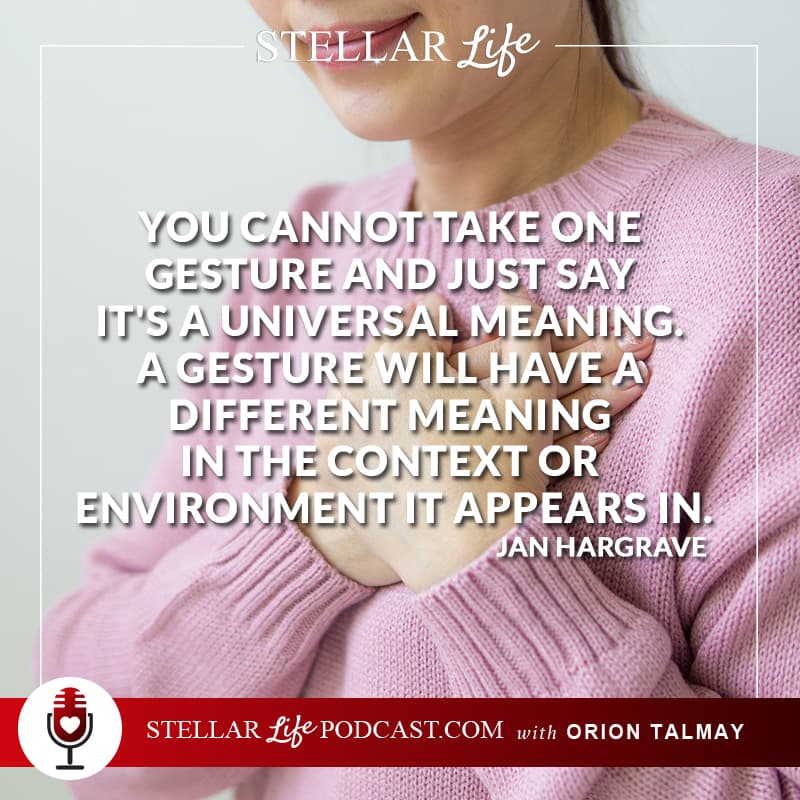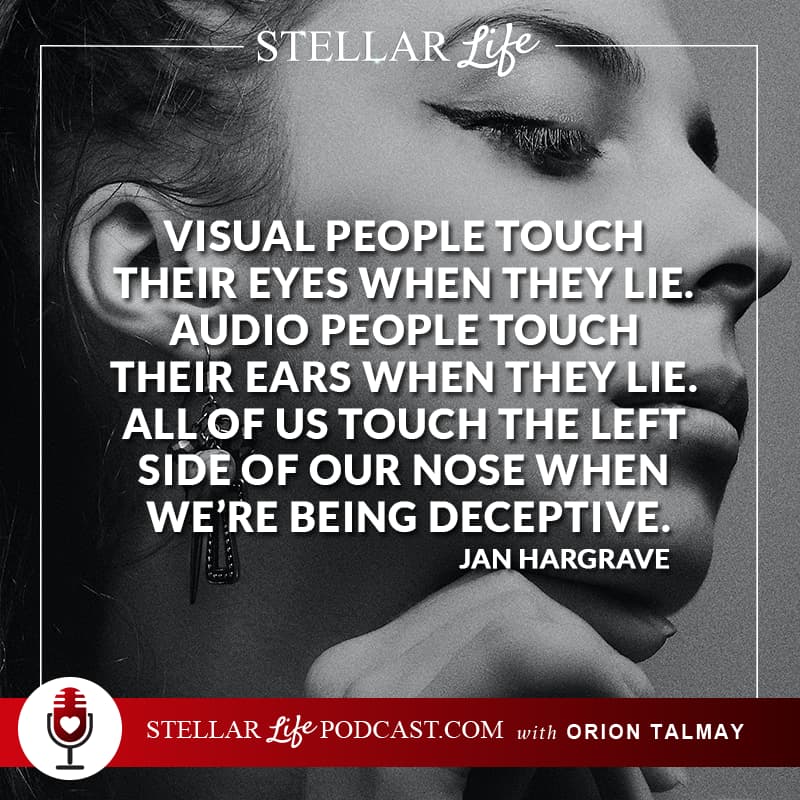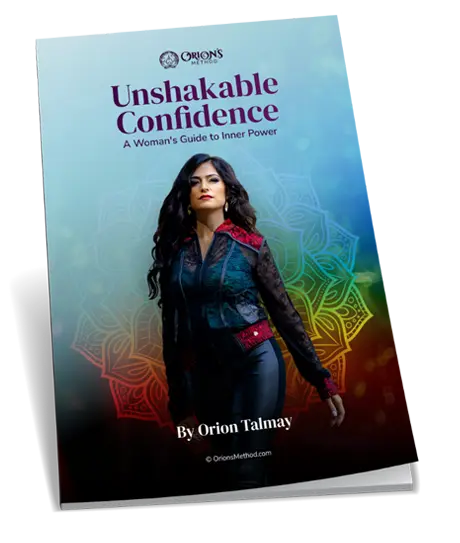
In this Episode
- [00:57] Orion introduces her next guest, Jan Hargrave, a leading behavioral authority, body language expert and trial consultant. She is also the author of Let Me See Your Body Talk, Freeway of Love, Judge the Jury, Strictly Business Body Language and Poker Face.
- [05:07] Jan shares the beginnings of her passion for reading people’s body language.
- [08:09] Orion asks the signs in identifying that a person is lying.
- [13:26] Jan emphasizes that even if people are left-handed, the left brain controls the right side movement, and the right brain controls the left side movement.
- [19:57] Jan gives an example of a person who is a compulsive liar and can conceal his lying but can be caught through sentence analysis.
- [21:35] Orion asks Jan to give an example of doing sentence analysis.
- [30:09] Jan explains the three things to look for in knowing body language: clusters, context, and congruent.
- [34:04] Orion wants to know the auditory part and ways to see a person is genuinely speaking through a phone.
- [35:06] Orion and Jan discuss identifying authenticity in personalities who speak in a very high voice.
- [37:52] Orion wants to know if Jan became a more honest person knowing that Jan can identify how people lie.
- [39:39] Jan shares her responses in watching television and trying to figure out the gestures.
- [41:01] Jan explains the gestures correlated with evaluation, encouragement and showing interest in the conversation.
- [43:41] Jan talks about her book Freeway of Love, a romantic body language, wherein she wants the reader to travel the highway of romance and remembers a song in every chapter.
- [49:04] Orion asks Jan if adopting body language can change emotions and the way we are.
- [50:58] Jan shares her three tips in living a Stellar Life.
- [52:40] Visit Jan Hargrave’s website to learn more about her courses and seminars. Also, check out her five books, namely – Let Me See Your Body Talk, Judge the Jury, Freeway of Love, Strictly Business Body Language, and Poker Face
About Today’s Show
Hello Jan and welcome to Stellar Life Podcast. It’s an honor and a pleasure to have you here.
Thank you so much. I’m thrilled to be here too. I’m always thrilled to teach my science to people, and always excited that people are interested in the world of body language and how to read others as they’re talking with them.
Wow. Can you please share with us how did you start with that passion of reading people’s body language? When did it start for you?
I guess I always had watched people, but the real way that it started, I was sitting in a graduate psychology class and had a really fun professor. Every few days he would walk in, he would point it at one of us, and he would say, ‘I know what you’re thinking.’ The next day, he came back with someone else, ‘I know what you’re thinking,’ ‘I know what you’re thinking.’ He kept doing that to us. One day he looked at me and he said, “Jan, I know what you are thinking.” I thought how can he know what I’m thinking? Because it always wasn’t too pretty.
I needed to learn this stuff because I thought what an advantage I would have all my life.
He told us about body language, and I said, “You mean, I can study how a person with his hands, arms, eyes, and his shoulders that I can figure the person out?” He said, “Oh yeah, yeah, yeah you can do it”. And I was dating someone at the time. I said to my college professor, “When this man tells me he loves me, I can figure out if he’s telling the truth.” He said, “Oh yes, you can do it.” I said, “I need to learn this stuff because I thought what an advantage I would have all my life. I could figure out if my boyfriends were lying to me or not.“
I just started researching and thinking, oh, this will be fun. But then as the years went on of college, my research in nonverbal began more serious. I did my graduate thesis for my Master’s in Body Language. I have a third degree. I also did a dissertation in the field with body language. I am a business major and a psychology minor. I’ve always taught at the college level, taught business during the day, economics. But always at the night school, I always taught some kind of psychology class, and primarily taught classes in nonverbal communication.
It started off teaching it for attorneys to help attorneys pick more favorable jury. Because you know, whenever attorneys speak to a jury, they want to pick someone who thinks like they think. While they’re asking maybe 80 prospective jurors, then I’m sitting there with a pen and pencil, I’m writing everything that I see from the body language. And then the attorney and I get to consult at the end of the day. I say yes, you need this lady on your team. No, we need to scratch out this lady on your team because she does not like you one bit. That’s how they use me, “Jan, the body language expert.”
Wow. You’re like the secret sauce.
The secret sauce. There’s a show now called Bull, and there’s a man who does what I do. We sit in the courtroom, we watch witnesses, or sometimes we prepare witnesses to maybe come across as credible and to come across as honest. Not thinking though, Orion, when I first studied it, I never knew how far-reaching it would be because I’d say what can people think about this thing called body language? Because years ago it was not looked at as hard science. It was just like a playful thing.
When I first studied body language, I never knew how far-reaching it would be.
But then years went on and it started off really with O.J. Simpson’s case because they had hired a woman, Jo-Ellan Dimitrius was another big body language expert and they hired her to pick that jury. That’s when people started hearing the word jury consultant, jury consultant, and then I started realizing, wow, there’s a seriousness to everything that I’ve studied.
For somebody that is just starting, what are some telltale signs to know that someone is lying to you?
Okay, everyone always wants to know that. How can I tell if he’s lying to me? Or as I told you earlier, people say to me, Jan, I would hate to be married to you and I tell them I would need to be married to me too. Because I’m sure that I drive my husband crazy. Just think about having a conversation with me, Orion, and he’s moving his finger, and okay, I know what’s going on.
Let’s go back and just think about body language. Think of it this way. The moment that someone sees you, they get an impression in their mind formed about you. In fact, in the first 2–7 seconds of someone laying eyes on you, they decide for themselves, do I like that person? Do I trust that person? Do I even want to have a conversation with him? All of that is based on body language because the person hasn’t even said a word yet. They’re looking at your hair. They’re looking at your smile. They might be looking at how your shoulders are.
That’s why nonverbal is really, really important. I’ll give you the percentages so that the listeners can really get a good grip on learning this. Fifty-five percent of our communication is nonverbal—55%. That’s why when people first see you, they get this impression of how they feel about you. Thirty-eight percent of our communication is simply voiced inflection. Even if right now we’re just hearing someone’s voice, you can kind of tell if that person is happy by listening to the sound of their voice. That is 38% of our communication.
Research says that only 7% of our face-to-face communication comes from the words that we say. That’s why we say actions speak louder than words. We say a lot with our bodies. Your body is never not sending a message. Even if you’re sitting still, I still can probably read you because maybe you have your right leg crossed over your left leg, maybe you have a tilt in your head. Every one of those little things that you do tell me information about what’s going on inside your mind.
The moment someone sees you, they get an impression in their mind about you. That's why nonverbal communication is really important. Share on XThink of it this way, the words that come out of your mouth give me information about the knowledge contained in your brain. But every hand, or motion, or eye movement that you do gives me information about your attitude, your feelings, and your emotions. Your words tell me what you have learned so far in your life. But all of your motions tell me about how you’re feeling right now with your attitude, your feelings, and your emotions.
When we’re talking about deceptiveness, we have to lay a little bit of groundwork. I can teach different gestures and say, oh this person is probably lying. But when I coach people, I say, you can not base your findings on just one deceptive gesture. If I’m working with someone in the courtroom, I want to see two or three deceptive gestures before I say, oh, I am being lied to. That’s how we always talk about clusters of gestures to get yourself a good reading. Do you understand what I mean, Orion, when I say clusters of gestures?
Yeah. Because sometimes if somebody scratches their nose, maybe they just have an itch in their nose and they might not be lying. You look for more than one sign for that.
Correct. But at least, if you’re talking with someone and you know one of the gestures of lying and you see it, you could re-ask that question several different ways and several different times and see if you get a deceptive gesture every time you ask that certain question. Now that we talked about that, I wanted to tell you a few gestures that could be associated with someone being dishonest with you.

I want you to think of it like this, why do your hands move when you’re talking? The reason your hands move is that your hands are pulling from different sides of your brain to gather information. For example, when I move my right hand or anything that I move on the right side of my body, any motion that I do on the right side of my body is all controlled from the left side of my brain. Of course, my left brain is my analytical side, it’s my factual side, it’s my numerical side.
My timetables are located on the upper left side of my head. When I am multiplying something in my head and I have trouble getting numbers to multiply, I would start moving my right hand, it would help clarify what I’m thinking, and then finally, I could speak those words.
When I move my left hand or anything that I move on the left side of my body, that is all controlled from the right side of my brain. The right brain, this side’s the fun side, the comical side, and the creative side. The right brain daydreams. If ever you drove somewhere one day and you can’t remember how you got there, you drove there driving right brain.
You understand why the hands move. Your hands move to help you get all these thoughts in your head organized so that they come out in a logical fashion when you’re talking with people. Because if you had to speak with someone and never were allowed to move hands while you’re speaking, maybe they have to tie them behind you, it would become really difficult to organize your thoughts and get them out in a logical manner.
Now that you kind of understand, my left hand is controlled on the right side of my head. Think of it this way. When I make up a story or tell a lie, it is coming from my right brain, correct? You kind of get that feeling because that’s a creative side. If I’m telling my mom a story, it’s coming from my right brain. Therefore, if it’s coming from my right brain, when I gesture, when I’m being deceptive, more than likely, my gestures will be done with my left hand. You kind of understand it. It’s never that left-handed people lie more than right-handed people—never, never, never. It is always that people who will more so use their left hand.
What I understood is that the right brain is connected to the left side and the left brain is connected to the right side. If somebody is left-handed, what does that mean?
You can not base your findings on one deceptive gesture.
It doesn’t mean anything different. Even people who are left-handed their left brain controls their right side movement, their right brain controls their left side movement. Let’s say you’ve seen someone who had a stroke and they had a struggle in their right brain, they would not be able to maybe move their left leg or their left arm. The brain works in a diagonal way across the body. When someone is being deceptive, whether they’re right-handed or left-handed, it is still coming out of the right side of their head. All of us—no matter right-handed or left-handed—when we’re being deceptive, have a huge tendency to gesture with our left hand.
Three different gestures that people do when they’re being deceptive. They’re trying to distract you. Let’s say I’m telling you a story and part of their story is being made up. I’m telling you the story, but I’m trying to get you to think of something else while I’m telling you the story. Because think what’s going on inside the mind of a liar. They’re having to remember their lie, but they’re also trying to watch you to see if you are believing what they’re telling you. Do you understand? Think how busy their head is.
What we found is this, when someone is getting ready to tell you something and they know that it’s probably not true, they’re making it up, they’re going to take their left index finger. While they lie, most times they’re going to take that left index finger and they will begin to rub up and down the left side of their nose with their left index finger. They’ll usually rub up and down about twice on the left side of the nose, and then they’ll bend the finger and maybe place the hand underneath their noses—this is still all with the left hand.
Think about what’s going on when someone is doing this. When I’m touching my nose with my left hand, I am almost covering my mouth. Think about what’s going on. They are covering their mouth hoping that you don’t pay attention to what’s coming out of the mouth, that you’re more so paying attention to the hand motions that are being done in their face. It’s called a distraction. They’re trying to distract you, maybe with the ring they have on, maybe with pretty fingernails they have on, or maybe with the watch that they have on. Because if you’re in a conversation someone has a pretty ring on their left hand and their left hand is covering their nose, you’re not thinking about what they’re saying to you, you’re just thinking, wow, that’s a good looking ring.
A liar tends to bring a hand to the face because it goes back to when you were a little kid. When you were a kid and you said something you should not have said, you cupped both of your hands and you brought them towards your mouth. You’re like, oh, I can’t believe I said that. When we’re kids we say that. Even as an adult, we’re more sophisticated, we won’t bring both of our hands towards our mouth. But we will take that left hand and we’re going to pretend almost that we’re touching the nose and in it’s in effect trying to say I’m covering my mouth because what I’m saying to you is really not the truth.
A liar tends to bring a hand to the face.
If the reason that someone touches the nose when they’re being deceptive is a physiological effect, every time you tell a lie you get a tingling sensation in your nose, and because of it, you end up rubbing on the nose. It sounds crazy, but from all the research, this is what we have found. Kind of like the bubbles inside your nostrils. You’re trying to protect yourself from someone catching you in the lie so they kind of swell up, and because of that you feel this kind of tingling and itchy sensation.
Now you can have fun with this gesture. Notice someone Orion, rubbing their nose, saying you’re the best-looking thing I’ve ever seen. They won’t even know that you’re being deceptive with them. Let me give you lying gesture two and lying gesture three. Touching the nose, let me just remember to tell you this, that goes back to the Pinocchio effect.
Mr. Matthews seen politicians. Maybe it was Clinton, maybe it was Richard Nixon after years of being in trouble, they’d have them on the cover of Time magazine in a side view, and the nose is really, really extended like Pinocchio. That’s where all this story is. It kind of makes sense right now. It’s kind of funny, but it does make sense that the more the person lies, the longer the nose gets. With that hand motion when I’m touching my nose after I touch it, my hand kind of extends outward in front of me. I just kind of rub it and then the hand goes outward. In other words, pretending that I’m extending my nose.
When you think about the background of a gesture, it seems to make more sense, correct? The second two gestures of dishonesty or they’re all three done with the left index finger. So again, it’s taking your left hand, and while you’re telling someone a story, you point the left index finger just slightly. While you’re talking, you begin to rub on the outside of the left eye. Let’s say I’m telling you something and I’m slightly rubbing on my eye to the left just kind of tugging and tugging, that is a nonverbal gesture that says do not see very clearly what I’m saying because I am not being fully truthful with you.
I’m sure you were seeing someone tell you something and is kind of rubbing the eye or the upper left cheek. It has to be left hand, has to be left eye, or has to be left upper cheek. They’ll just tell you something because think about it, that is again a distraction. They’re trying to make you look there and not look at their mouth and focus on the words that are coming out of your mouth.

The third gesture of deception again is the left hand. It comes back to the left side of the face, and now they must start to pull on the left ear. You know someone would take the backside of the left ear, just kind of talk with you, and they’re just tugging at the ear. There is no sense that someone is doing that when they’re talking with you. They’re doing it hoping that you would look here and that you would not focus on the words coming out of their mouth.
When they’re tugging at the ear and telling you something, it’s almost simultaneously that they’re thinking to themselves, do not hear very clearly what I’m saying because I am not being fully truthful with you. Touching of the nose, touching of the left eye, touching of the left ear.
People seem to say to me, they say Jan, well, I understand why someone touches the nose because they want to cover their mouth. Yeah, attempting to cover their mouth, but why would someone touch his eye and why would someone touch his ear when being deceptive? These two touches refer back to that person’s preferred method of learning. Because in this world, people are either visual learners, auditory learners, or kinesthetic learners.
People who are visual learners have to see something for it to sink in their brains. People who are auditory learners have to hear it for it to sink in their brains. I am visual. I, as a visual person, if I lie—my husband doesn’t even know this, but it’s kind of cool to know—I touch my left eye. Visual people touch their eyes when they lie. Audio people touch their ears when they lie. All of us touch the left side of our nose when we’re being deceptive. It kind of makes sense now a little bit?
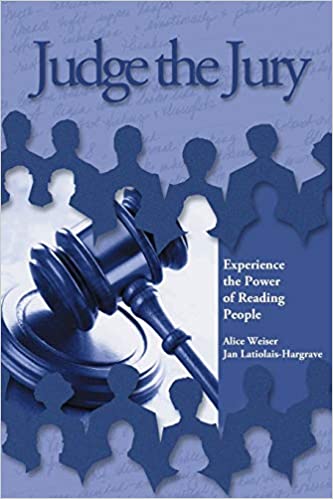
Yeah. It’s incredible. Do you think some people are such perfect liars that they can even control their body not to touch their eye, cheek, or ear?
Yes, I do. People who are compulsive liars like let’s say, Scott Peterson, the little girl in Florida Casey Anthony? Do you remember Casey Anthony, the baby missing 31 days?
No, no, never heard of it.
It was in Orlando, Florida. It was about, I would say, five years ago. Remember, Scott Peterson, Laci Peterson, the case in—
I think I was traveling the world and busy. I was too busy having fun.
It was a case in California. I happen to have done their body language for TV. Normally, I do work for ABC News, NBC, CBS, and I’m even doing the body language of certain politicians or certain people accused of crimes. But yes, so people who are really used to lying and that they’re comfortable with it, they probably more can conceal that they’re lying. They probably wouldn’t rub their nose, they wouldn’t rub their eye. But we catch them in other ways. The other ways would maybe be even in sentence analysis when they’re telling us a sentence. People form sentences truthfully a certain way.
When people are being deceptive, the sentence has keywords in there that let you know. People who start sentences with, ‘I swear to God’ or ‘honestly,’ typically those sentences will have some kind of deception in it. Or people who use the present tense and past tense in one sentence, we call that when we’re doing standard analysis. It could be a deceptive sentence right there.
Can you give me an example of that?
They say, I am going to the house. I went into the house earlier today. ‘Am’ would be present tense and ‘went’ would be past tense or they use a different tense in the same sentence. I can’t think about a sentence right now, but Bill Clinton was also guilty of that too. I did Bill Clinton’s body language, by the way. He rubs his nose once every four minutes when he was testifying.
Are there other signs?
They’re doing it hoping that you would look here and that you would not focus on the words coming out of their mouth.
Of deception? Hundreds of others. You have to think of it this way, we call them displacement gestures. Displacement gestures are gestures that are done that are not necessarily gestures. If you could see me right now, I’m taking my right hand and I’m just rubbing up and down my neck with my index finger. That is a displacement gesture.
Someone who is always fixing their clothing and pulling on their jackets, that’s a displacement gesture. Someone pulled pieces of imaginary lint up in their clothing, that’s a displacement gesture. Even someone who tosses their hair too much. Anytime that someone does a gesture that’s not really a necessary gesture, it’s a gesture that’s done because they’re nervous. Maybe someone taking one of their hands and scratching their other hand. Let’s say I’m taking my right hand and I’m just scratching on top of my left hand for no reason, that’s a displacement gesture.
You can usually tell how nervous someone is about what they’re saying by how many displacement gestures they do while they’re talking with you. Because people who are being honest, they would just talk with you, their fingers are probably going to be wide apart, and they’re just explaining their issue. People who are nervous about what they’re saying will do all kinds of unnecessary gestures while they’re giving you their story.
Another thing that we have to let our listeners understand is that people trust you faster when they can see your hands. Lately, I’ve been doing a lot of training about virtual conversations.
Oh, that’s so good. Yes, let’s talk about that.
Yes, because even on a virtual screen you still have to come across as honest and dependable. I prepare TV anchors, and I’m sure there are some TV anchors you like more than others, and it’s because you trust them, because you like their body language. The same thing that we train TV anchors with, we now train people on virtual screens. One of the things that I always train them is at sometimes when you’re talking with another person, you have to let them see your hands because people trust you faster when they can see a few hand motions from you.
Visual people touch their eyes when they lie. Audio people touch their ears when they lie. All of us touch the left side of our nose when we’re being deceptive. Share on XNever crazy hands. But maybe you raise your hand, your face to count with your fingers with number one, two, three. I’m coaching people now that you need to probably gesture to the right or left side of your face. You never want a gesture in front of your face because your hand gets bigger when it gets closer to the camera. So you probably want to gesture to your left.
The reason about hands, just to give you some background on it, think of hands. Hands gave birth to you, hands held you when you were a baby, when you’re a kid and you were upset, your mom, she probably held, she held your hand. You married someone who held their hand. You get older, you hold someone else’s hand. But hands can harm you, hands can hurt you, and hands can kill you. That’s why the police officer says, show me your hands. Because without us noticing it for our safety when we see someone in person, we’re looking for survival. We’re always in survival mode. All of us are.
When you’re having a conversation with an individual, you feel safer when you see a few hand motions from them. So I tell men, you cannot have 30 minutes of conversation, with a woman especially, and keep your hands in your pockets the whole time that you’re talking with them. Because when people can see your hands a little bit, they take a deep breath and they say, oh, I feel safe around this person. It’s just a small thing that we don’t think about every day. But it is prevalent and we have to think about it in society.
One gesture that’s really good to show on a virtual screen, and I’m putting my hands almost as though I’m in prayer, but I’m not touching my wrist together. I’m just touching the tips of my fingers together. Can you picture in your mind what I’m doing? It’s called a steeple. That’s a steeple in body language. It is probably the biggest sign of confidence that I could ever teach a group of people.

Anytime you’re going to see this formation with someone’s talking with you, whether the fingertips are touching or whether the fingertips or three or four or five inches away, but their hands are still kind of in a steepling position, that’s called a goal post steeple when their hands are not touching. Every time you’re going to see that gesture, it is always, always associated with the level of confidence with the person who is speaking with you.
That’s one thing that everyone can do on a virtual screen every now and then, maybe do a steeple gesture. Even just my pointer fingers together and I’m talking with you there, I could still make a steeple. With my thumbs just facing each other together at the top, I could make the steeple. Steepling is really interesting that people will do.
One other thing probably that you can do when you’re on the screen, when I cup my hands. Let’s say I’m talking with you right now and I’m cupping my hands. Cupping your hands represents that you have a strong idea in your mind and you want to share it with another person. So when you’re talking and your hands are cupped, and then one thing that I think people can always remember is upward-facing palms always show acceptance, downward-facing palms are more of a controlling display.
If I’m talking with you and I’m trying to bring information from you, I’m going to probably talk with you and my hands are going to be upward, kind of pulling you into my circle. I’m just taking my hands and describing, but my hands are kind of cupped in. I’m kind of bringing them towards my body as I’m speaking with you here. If I’m talking with you and my hands are facing downward, that is a non-verbal message that says I want to control you.
You might not want to do that in a virtual call. And then I tell people, kind of have the screen that it’s about at chest level. Don’t let it be just your head because I don’t get you if it’s just your head. I cannot see your sweet personality, I cannot see the eagerness of you to have a conversation with me if it’s just your head. I need to see at least until your, I would say, chest level.
Also when we coach people about the virtual screens, I always tell them you have to have your shoulders level and completely facing that screen. Because unevenness of shoulders is the indecisiveness of a person. If I’m talking to someone on his screen and one of my shoulders is higher than the other shoulder, the entire time I’m talking with them, they won’t realize what it is. But after a while, they’ll start feeling uncomfortable. The human eye likes symmetry. Even when you’re gesturing, it’s always better to have your gestures look like each other.
Let’s say I’m taking my right hand, and I’m just scratching on top of my left hand for no reason; that’s a displacement gesture.
Right now, I have my hands kind of facing each other but they’re about six inches apart. It’s always better than, let’s say if I’m gesturing and one of my hands is near my eyes and my other hand is at my waist, that can kind of make people crazy. The eye likes it when the two gestures are looking or mirroring each other.
Shoulders set the tone for the entire meeting. The way that your shoulders are when you come on the screen. Let’s say you’re having a luncheon meeting with someone at a restaurant and they got there before you got there. Then you got there, you’re looking for them, and you see them in their chairs and their shoulders are all slumped. They’re telling you right there, they’re not that excited to have a meeting with you.
As much as you can, your mom said you put your shoulders up. Our moms probably were right because it’s kind of military and it’s powerful. You look a lot more powerful when your shoulders are—in yoga we kind of put him in that back socket. Your shoulders are like that because those people will form an impression. Do you remember 2–7 seconds? If you’re looking all disheveled and your shoulders are not quite right.
And then with the arms, it’s always better to be open with my hands kind of spread a bit instead of with my hands or arms in front of my body, of course, that’s defensiveness. And you know how sometimes you cross your arms in front of your body, it’s as if you’re thinking I don’t care what you’re saying. I do not want whatever you’re saying to penetrate the way that I feel.
The only acceptable arm crossing that we allow in teaching college negotiation classes is when hands and fingers are visible. Orion, if I’m crossing my hands, the only way that you can cross your hands is to cross your arms and let me see your fingers. Let’s say right now I’m crossing but I’m holding on with my hands to my upper arms. Do you understand? That’s better, it’s more so you were in contemplation. If I’m not showing you any hand whatsoever when I’m crossing my arms across my body, that is a really negative defensive pose. Do you kind of get the difference between them?
Wow. Yeah, I’m actually moving as you speak.
Me too.
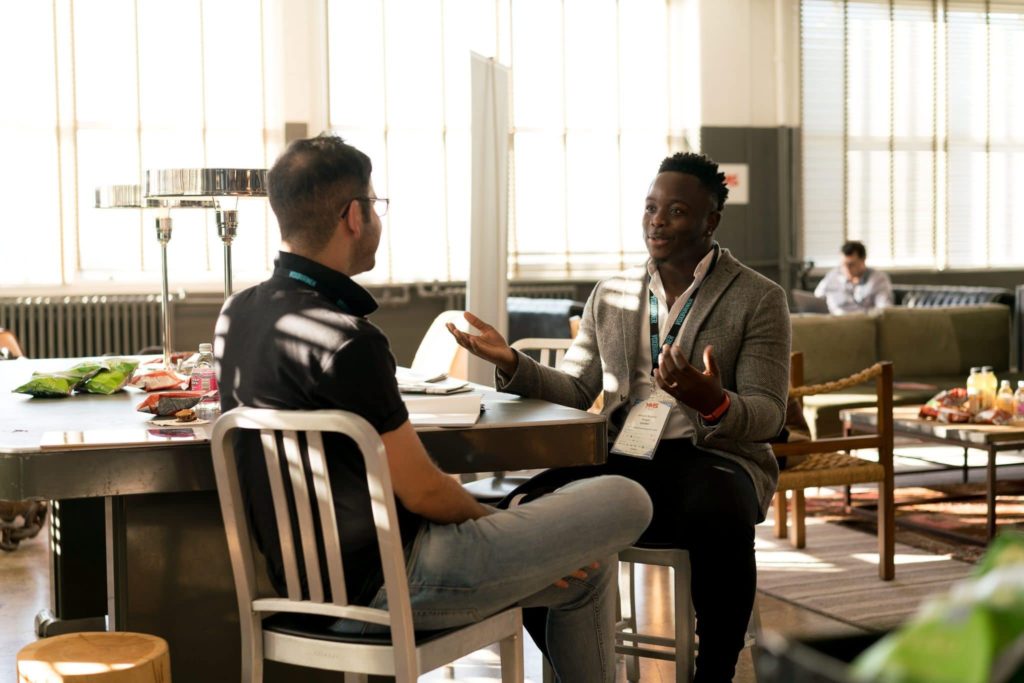
I think our listeners can understand that when you’re listening, try to show at least, even if it’s just one of your hands that showing the other might be underneath the other arm. It’s more so you are in contemplation and you’re thinking about what’s being said. As opposed to holding your arms really tight and you cannot see your hands at all.
When we talk about body language, another C. The first C was Clusters, that you would look for more than one. The second C is Context. By context I mean when you see a gesture, let it be arm crossing. it does not mean the same thing in every environment. Context is the environment. If I see a woman on a cold winter night sitting on a park bench and her arms are crossed, she’s telling me that she’s cold.
But if I see a business executive in a meeting room and his arms are tightly crossed, he’s probably telling me that he does not want to listen to what I’m saying. You cannot take one gesture and just say it’s a universal meaning. That gesture will have a different meaning in the context or the environment that it appears in.
You said cluster, you said context. What was the third one?
People trust you faster when they can see your hands.
I didn’t say the third one yet, but clusters would be that you find more than one. The second one is context. You have to really think, where is this gesture appearing? What kind of meeting is it or what’s the setting? The third one is Congruence. By congruence, I mean, when you’re trying to analyze them you have to think to yourself, does the wording that they’re saying match the gestures that they’re showing you?
If I would say to you, I like you so much with my head going into a no. Actions speak louder than words. People will believe the gesture before they believe the words, so congruent. If someone says I’m happy to see you and their body language is all open, they’re really excited and have a genuine smile, that’s me, that’s perfect congruence. But if I’m saying I’m happy to see you with my voice is not even excited, that’s what we call incongruence.
When you have an incongruence of body language and the words coming out of the person’s mouth, people will not trust what you are saying. It has to all match. Sometimes I might watch a politician who knows that a steeple is a sign of confidence. They kind of know that because politicians know some things about body language. But when I’m watching him on TV, I noticed that he does not use it where he should in the sentence.
For example, let’s say he’d say an entire sentence and then when the sentence is over, I noticed it he would say to himself, oh, I forgot to do the steeple gesture and do it right there. You can see what happens when the gesture does not appear because a real gesture comes out about 125th before the word that matches it comes out.
Oh, wow.
That’s how you can probably tell if someone is trying to pull the rule over your eyes is that they’ll do a gesture either too delayed or too early, too fast. One good way to study body language is to watch television with no sound on. Because then when you’re watching it even with no sound, especially with soap opera, you could tell what’s going on, correct?
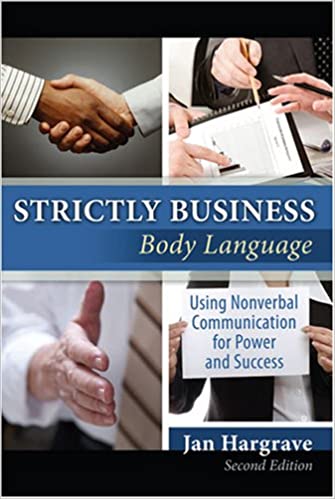
Just remember this about hands in general. Hands are like windows. When the weather is nice and there’s a breeze, the windows are open. When you’re happy and you’re carefree, your fingers are wide apart. The more comfortable you are, the more there is space between all of your fingers.
Let’s say on a cold winter night and it’s bad weather outside, those windows are closed. When you’re angry, upset, and nervous, your hands are also closed. Sometimes they’re even in a fist where you would punch out at someone. Let’s say you’re just watching someone from a distance and you’re thinking, okay, let me just try to study their body language and figure them out. Just look, as you’re talking to someone else, how much space you see between their fingers.
If they’re talking and their fingers are all wide apart, they’re feeling pretty good and they’re confident with what they’re saying. If they’re talking, their fingers are really all tied together, and their hands are tight, they’re uneasy with what’s going on in that conversation. It’s a quick little read of someone.
What about the auditory part? Sometimes, we’re just on the phone. How can we hear if somebody is not genuine with us?
People ask me about wearing masks. If you can’t see their face, how will you read their facial expression? It’s going to come out in your voice. Because when you are smiling, and you’re talking with me on the phone, I can tell in your voice that you’re smiling.
Even if someone has a mask on, you can’t see me now, but you know and I think my voice sounds like I’m pretty chipper. I think by just listening to someone’s voice you can tell if they’re into what’s going on or if they’re really paying attention to what you’re saying because if the voice is just a monotone, they’re probably wanting to be somewhere else.
There are only two things we study about voices. When someone is stressed, strained, and probably lying to you, the voice gets extremely high. When people lie, the voice is high. When people are afraid, the voice gets really, really low.
You cannot take one gesture and just say it's a universal meaning. A gesture will have a different meaning in the context or environment it appears in. Share on XWhat about those new icons, actors, and reality show stars? A lot of the time, they have this very high voice that’s not authentic. Does that mean they’re not an authentic person?
Is it when they’re being interviewed, or is it when they’re in a movie?
Some people have it all the time.
Can you give me an example?
Nothing comes to mind, but I just feel like sometimes, I hear people with a very high-pitched voice.
With a high-pitched voice, it probably is a mixture of excitement. It depends on what the subject is that they’re being asked about. But normally, people talk like this, like you and I are talking in a normal tone. A lot of times, the tone of voice someone speaks with is dependent on if they are an extroverted or introverted personality.
I have a family member and she speaks with a very, very high tone voice all the time.
Is she extroverted?
She’s very extroverted.

She’s loud. You see, loud people—I’m kind of loud—we speak in that big voice. People who are introverted—think of accountants or engineers—a softer voice. A lot of that has to do with our personality. It’s never that someone’s being deceptive. I think it’s more so if they’re introverted or extroverted personalities. It’s a hard thing to read, but in the courtroom, we listen to the voice. We’re listening to the voice, and we’re listening to see if it’s high or if it’s low.
We train over certain voices and certain sounds that we hear that give the person away. But yes, someone talking in that high voice like you’re telling me—this woman who you know—can be deafening after a while to others. It can get you tired listening to their voice.
When we study TED Talks, TED Talks are 18 minutes long. In TED Talks, we’ve measured that there gestures are between 200 and 600 gestures in 18 minutes of a TED Talk. Those TED Talks that are most popular and most often watched are the TED Talks that have between 100 and 600 gestures as they go. The most popular ones are about 400 gestures in this 18-minute video.
That lets you know that people will listen to your voice, but if it’s too convoluted, fast, and crazy, after a while, you’re not going to be listening to it for too long. Because there’s nothing about the voice that is soothing. Sometimes, the mind needs a break from having a voice that goes blah, blah, blah the whole time. The average mind of a person listening will need a break in that.
Right. Do you think you became a more honest person now that you know how people lie?
No. I have some friends. Sometimes, I’m having dinner with them and I’m thinking to myself, did she just lie to me? Sometimes, they forget what I do for a living, but I’m always on it. I won’t say anything, but in my mind, I know. The way to catch someone really in the lie is to let them tell you their lie. We’re talking and you think to yourself, I think that she just lied, but you can’t say anything right then. Talk about something else and then you come back to them and say, so tell me that story again.
When people are deceptive, the sentence has keywords that let you know. For example, when people start sentences with, ‘I swear to God’ or ‘honestly,’ typically those sentences will have some kind of deception in it. Share on XWhen they tell you the story again though, you have to be prepared to ask them a question about something that happened at the end of the story. You need to ask them at the beginning of the story because when people make up a story and they memorize something, they memorize it step by step by step by step. Someone might say at five thirty-two in the afternoon, I exited Walmart. At five forty-five in the afternoon, I felt a hit on my head. That’s a practiced story.
If you feel you’re being lied to, you can’t just say it to them, but you can delve enough and ask enough different questions about it that they’re going to figure in their head that they got caught, that you figured them out, and that you caught them in their lie. You never say they were caught in a lie, but they’ll know you caught them in their lie.
It’s like a mama working with a child. You can’t just say, come on, you just lied to me. Talk about something else and then come back and say, so tell me that story again. But you have to be prepared to ask them something from the end of the story in the beginning when they start asking you the question. Isn’t that funny? It’s so funny, the world of body language. Now, I guess I just can’t stop it. I do it every day.
How can you watch TV? If you watch the news, how can you watch the news?
One gesture that’s good to show on a virtual screen, putting your hands almost as though you’re in prayer but not touching your wrist together.
I do watch the news. I do. I see myself at airports when I’m waiting for a plane. I’m looking at this person and this couple. I’m like, oh, he’s lying to this woman, or he’s trying to pick this woman up in a bar. What’s most fun for me is watching people in a bar and trying to figure out who’s trying to pick up who. Don’t you think that’s the fun part of this whole job?
For sure. I do that sometimes. I look at people and like, yeah, they’re just dating. Interesting. They’re so cute. Everybody behaves so well when they’re just dating for the first time. They are all so polite to the waitress. They look at each other and they say the right things.
Right. Sometimes, what we’re trying to figure out is is this their first date or the second date? There are some other things that people could do on a virtual call too. Right now, I’m taking my right hand and I’m kind of rubbing underneath my chin back and forth. There are men who will rub their chin back and forth, that is a huge evaluation gesture. He’s thinking, how much of this stuff is true?
If you’re going to bring your hands in your face, that would be the only acceptable hand motion that I would let someone do—either rubbing the chin back and forth slightly and then bringing your hand back down or taking your thumb and your index finger and just pulling on the bottom of the chin just for a bit. You bend your index finger and just pull.
This is a gesture Tony Robbins does a lot.
What is it?
The one with the thumb and the finger. He brings it to his chin.
And pull it a little bit?
Yeah. He does that a lot.
Rubbing of the chin is simultaneously correlated with evaluation—always, always, always. A woman might take her pointer finger, put her pointer finger up, and just put it on the side of her face. That also is called critically evaluating. The whole head in the hand is boredom, but when the finger is up and you’re just resting there, it’s critically evaluating. It is a good gesture, but you probably would not want to do it if you’re talking on a virtual screen. But definitely, you would want to do it while you’re listening to someone else talk.
Also, I encourage people and I tell them, while you are listening to someone on a virtual screen, you must nod your head every now and then, and you need to smile back at that person because those two gestures are an encouragement to another person to let them know that you’re there and you’re listening. You’ve got to just, every now and then, nod your head and let them know, hey, I’m here. I might not agree with everything you’re saying, but at least I’m here.
Shoulders set the tone for the entire meeting.
We relate it this way. We say two head nods mean that they agree and they’re listening. Three head nods mean that someone would like you to be quiet because they have something to say at that time. Because normally if you listen, you go uh-huh and your head goes up and down. When you’re ready to talk, you put your head up and down three times.
When I’m on a virtual screen and I see someone do that, I know that I need to be quiet as they probably have an item they want to bring up. Another point too is when people have a slight tilt of the head, it means that they’re really into what’s going on. Slight tilts are wonderful.
I do it a lot naturally. Even now before you said that.
A slight head tilt is a wonderful sign because you would never tilt your head if you were not comfortable in a situation. The reasoning is because the neck is really a vulnerable area of a person. People could strike you and hurt you, so you will never expose your neck unless you are comfortable with that person.
You can just watch. If someone’s listening to you and their head is tilted to the side, it means that they’re really into that conversation. When someone keeps their head straight up and down, it’s as though they’re thinking, when is this thing going to be over? I want to get out of here. The head straight up and down. It’s like anticipation, get out of here. If the head is just to the side, it says I’m analyzing and I’m into what’s being said.
When we talked about the bar, watching someone in the bar. I wrote five books, but one of my books is on romantic body language. Gestures that men or ladies do that say, oh, baby, I think you’re so good looking. That book is called Freeway of Love. Do you remember the old song, Orion, Freeway of Love? Have you ever heard that song?
No.
I think it was, “We’re going riding on the freeway of love in my pink Cadillac.” When I wrote the book, that was my intent. I just wanted the reader to travel this highway of romance. Chapter one, you see someone across the room who looks good. Chapter two, you’re looking at them, and they catch you looking at them, so there’s an eye protocol in that. Chapter three, you’re getting closer to them.
The book has 11 chapters, but each chapter brings you closer and closer. Since I had named the book a song, I had this bright idea one Sunday afternoon. I thought I would just name every chapter in the book a song. Chapter one in that book is titled, Let’s Get It On. That was an old song.
I know that one.
A slight head tilt is a wonderful sign because you would never tilt your head if you were uncomfortable in a situation.
That’s the first chapter in that book. Chapter two is about eyes so I titled it The Look of Love. It was a song by Sergio Mendes. Chapter three, they’re getting closer to each other. I used Roberta Flack’s The Closer I Get To You. There are some fun chapters. I put a chapter on legs and I used She’s Got Legs by ZZ Top. I did a chapter on Kiss’ and I put Prince’s song, Just Want Your Extra Time and Your Kiss. Then I did a chapter on lying—how do you spot when lovers are lying to each other—and I titled it Smooth Operator by Sade.
I know that one. Smooth Operator.
You have a good voice. That’s so good that you’re saying that because my intent was that when people saw the names of the chapters, that song would stay in their mind the whole time they read that chapter.
It’s a good anchor. It’s a great anchor. They’ll remember everything.
In that chapter on Smooth Operator, I listed the 101 most often told lies that lovers tell each other. I listed 101. Lie number two is I love you. Lie number 10 is I’ve never done this kind of thing before. Lie number one is either I’ll call you or I’ll text you. Number one lie, I’ll call you. Now you can’t because they’ll rub their nose and say yeah, baby, I’ll call you.
Do you want a couple of gestures that men and women do that say come on over?
Oh, yeah.
People who are nervous about what they're saying will do all kinds of unnecessary gestures while they're giving you their story. Share on XLet’s say you’re talking with a guy, he thinks you’re nice-looking, and he doesn’t know how to tell you that he finds you really attractive. The number one thing that guys do is that a guy will reach down and rearrange his socks. Sock-pulling is the number one.
I live in Texas. I see men digging cowboy boots for socks. Sock-pulling is a big part. It’s a displacement gesture. Orion, think where it comes from. You might hear one young man say, if you just see this girl, she will knock your socks off. You will never look at sock-pulling like—now you see a man where you say, oh, he’s pulling up his socks. It’s the number one thing that men do. That’s cool to know, huh?
Very cool to know.
Now, you’ll remember. When you see someone, you’ll say, oh, Jan told me about these guys. That’s what it comes from. It’s like the Cinderella effect in shoes. Another thing that a guy does—let’s say a guy and a girl are talking and he’s holding on to a Coca-Cola can. What do guys do? They have a can in their hand, they squeeze it, let it go, and squeeze it. Every time he squeezes it, he’s thinking to himself, I’d like to squeeze you, baby. You might want to watch the can.
There are hundreds. Men think that if the lady touches her hair, she likes him. That is not the first thing that ladies do. Ladies do three things before they even touch their hair. The first thing a lady does, a lady always crosses her leg towards the person she feels is most attractive. We always cross towards people we like and away from people we don’t like. If there’s a man sitting on my right side, I will cross my legs towards him.
The second thing I do once I’m crossed towards him is I may take the upper leg and I’ll slowly start swinging it. A slow swing is like, yeah, baby, you need to look at me now. You never want to see someone who’s kicking fast. A fast kick or swing is a sign of impatience so you never want that. It’s like a rhythm. You’re kicking the foot.
Then, the number one gesture that women do that’s equivalent to the male sock-pulling is the dangling of the shoe. Women dangle their shoes and men pull up their socks. It goes back to the Cinderella effect. At the beginning of time, years and years ago, it was shoes that were hung behind wedding horses. Now, it’s cans and everything else, but it was shoes.
Then after she’s done those three things, that’s when she starts to touch her hair. The more that she touches her hair, the more she’s into the guy. I tell people, you cannot touch your hair a lot during a serious business setting because it will undermine everything that you’ve laid down on that table. It’s too frivolous. Pulling off the hair or tossing the hair in a serious business meeting is really thinking to themselves, do you think I look good enough for you?
Sometimes they’ll take the hair and roll it over their head. That means they’re getting hot under the collar. They’re doing this. It’s okay to do on a date and stuff like that, but not too much in a serious business meeting.
I have a question. If we adopt a strong body language, can it change our emotions? Can it change the way we are?
Yes. It’s the best question people can ask me because let’s say you’re having to go on stage to do a speech. You’re behind the curtains and you’re rubbing all your hands together. You know what I’m doing, Orion? You’re just like, oh God, I can’t believe I have to go on stage. You’re doing this and this. If you just stop doing that, stand there for a second, and do the steeple gesture where your fingertips are touching, the gestures can calm you down and give you the confidence that you need.
It’s like with prisoners. We’ll take prisoners and we’ll change their handwriting. Sometimes, we can change their behavior, the same thing with gestures. When kids would go to school on picture taking day and they had to wear good clothes, they always behaved better than on days they just wore regular clothes. The kind of clothing you have or the way your shoulders are pushed back can put you with an air of greatness and of confidence.
Jan, you’re unbelievable. You’re so fascinating. Your wisdom is incredible. I personally want to learn everything that I can from you.
Thank you. It’s a fun time.
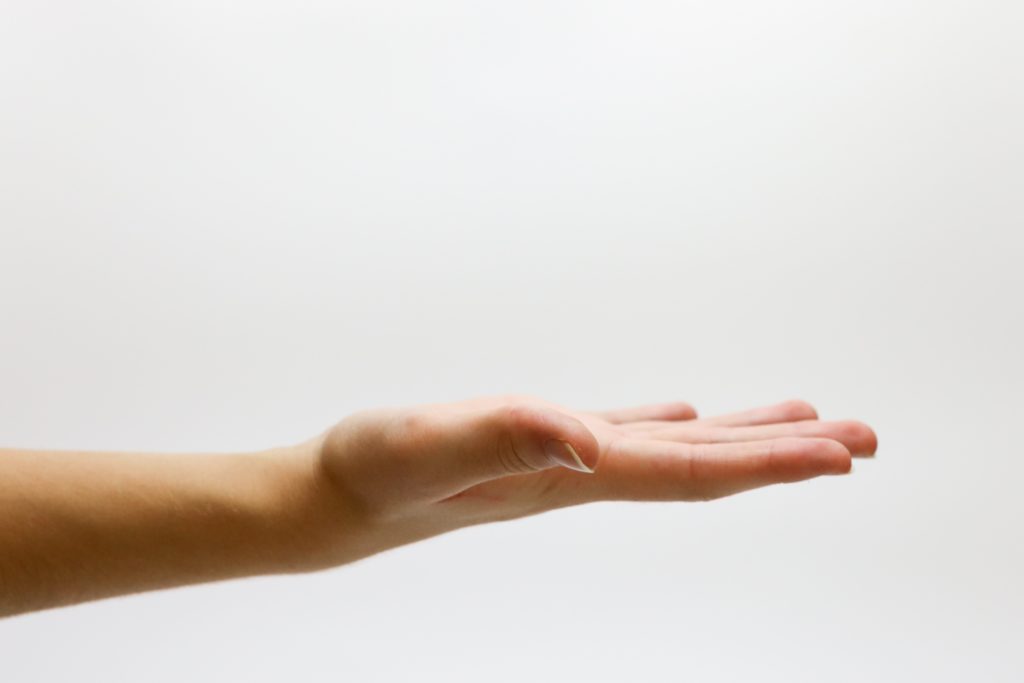
You also are a fun person. You don’t just teach it. You’re so much fun, and you’re lovely and lovable. It’s just an extraordinary combination.
Thank you. I was a teacher for so long, but I think I teach in a fun way. When you teach someone something and you give them the background about that gesture, it more or less stays in their mind and becomes permanent learning for them. My goal is that people learn and use it to their advantage in a job interview, in a business setting, on a date—wherever they need—on a virtual call.
I wish you come back on the show again and we can have more of this goodness. But I want to be respectful of your time today. Before we say goodbye, what are your three quick top tips to living a stellar life? Then, where can people find you?
I guess the top things to living a stellar life are courtesy to other people, sometimes making people feel that they are superior to you even though they are not—not being superior but that they’re special. Maybe you remember their name or maybe you’re checking out how they do. That sets a good light for you, always.
Then just try to think as positively as you can about every situation that comes into your life because life is hard. You have to keep your little brain okay. Maybe the way to keep your little brain okay is to do some outside reading and to really delve down into your own little system because everybody’s fighting a battle, everyone who we meet. Some are just a little bit tougher than others. We can show them that courtesy, but we always have to remember to take care of ourselves too.
You need to have some fun. You need to have some good friends. You need to talk things over with people. Maybe sometimes listening to some of the topics you have, Orion, is really good. I looked through all of your topics. Anything that I guess we can do better for humanity, we will sit well with the gods.
My website is my name. It’s just janhargrave.com.
People can learn how to do some of the things that you do.
Correct. I have an online course that they can purchase if they’d like. By listening to me today, if they want to get the special—because we always do that when someone’s in one of my courses or one of my seminars—just put janhargrave.com/special, and you get a big reduction on the course itself.
My five books are also on the site. My first book is Let Me See Your Body Talk. That’s body language job interview, body language presentation skills, and body language gender differences.
My second book is Judge the Jury. That’s everything we do in the courtroom, so it’s really how to spot a liar.
My third book is Freeway of Love, and that’s boyfriend, girlfriend, husband, wife lover’s body language.
My fourth book is Strictly Business Body Language. That is simply sales and negotiations, and is filled with pictures of people sitting in all kinds of crazy ways, and then I analyze it underneath there.
Then, my last book is titled Poker Face because I train professional poker players. With that, that’s a good array of things.
It’s a wonderful array of things. Pretty wonderful.
Finish my writing career. They can get all that on my site. It’s easy. It’s just janhargrave.com.
Perfect, Jan. Thank you so much. It was so much fun and very exciting for me to learn. I appreciate you. Thank you so much for being here.
You’re welcome. It was my pleasure. I’m happy that you got in touch with me.
Thank you, and thank you, listeners. Remember, be courteous to other people, make people feel special, think positive as much as you can, have a lot of fun, and have a stellar life. This is Orion, until next time.
